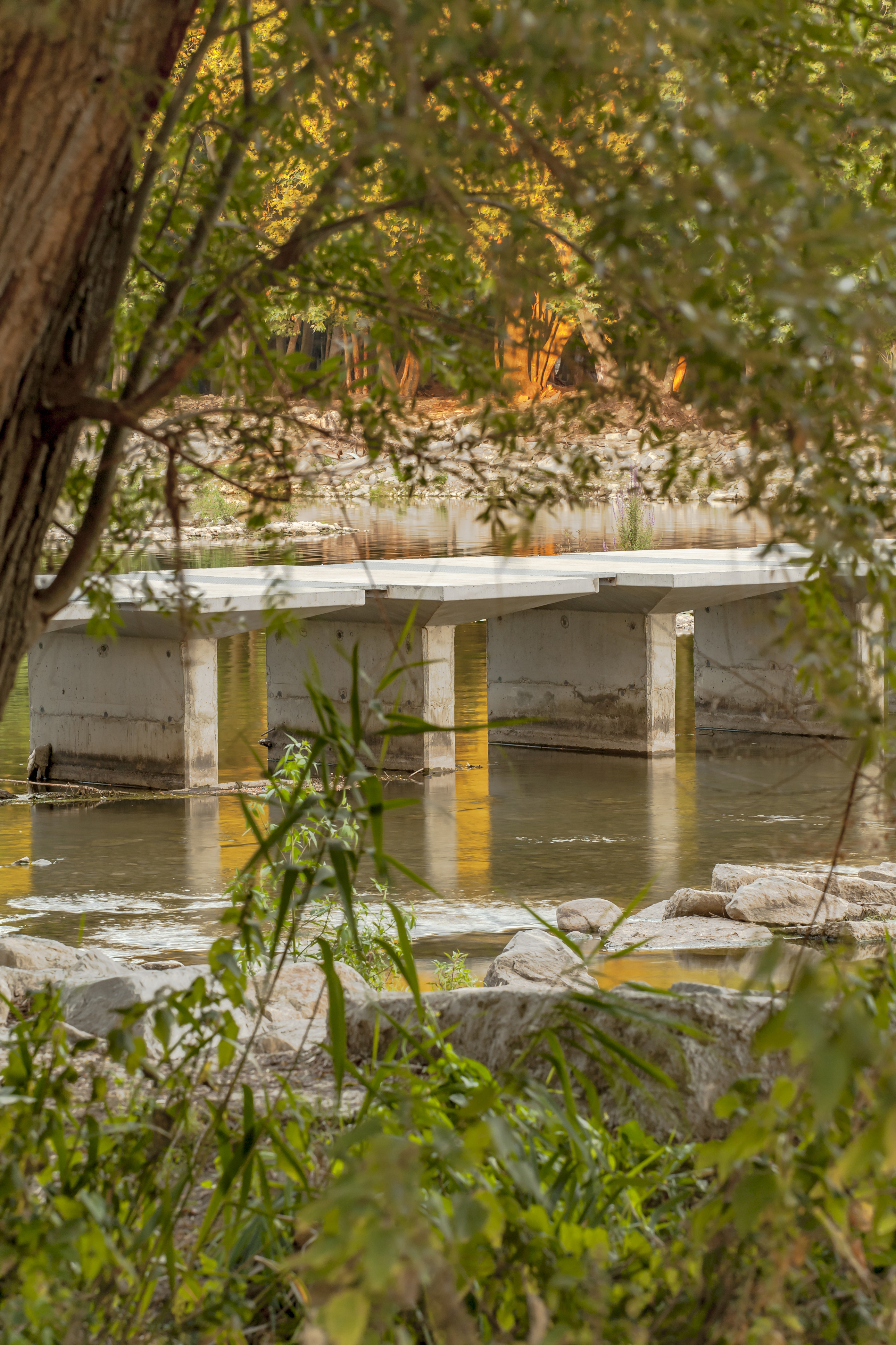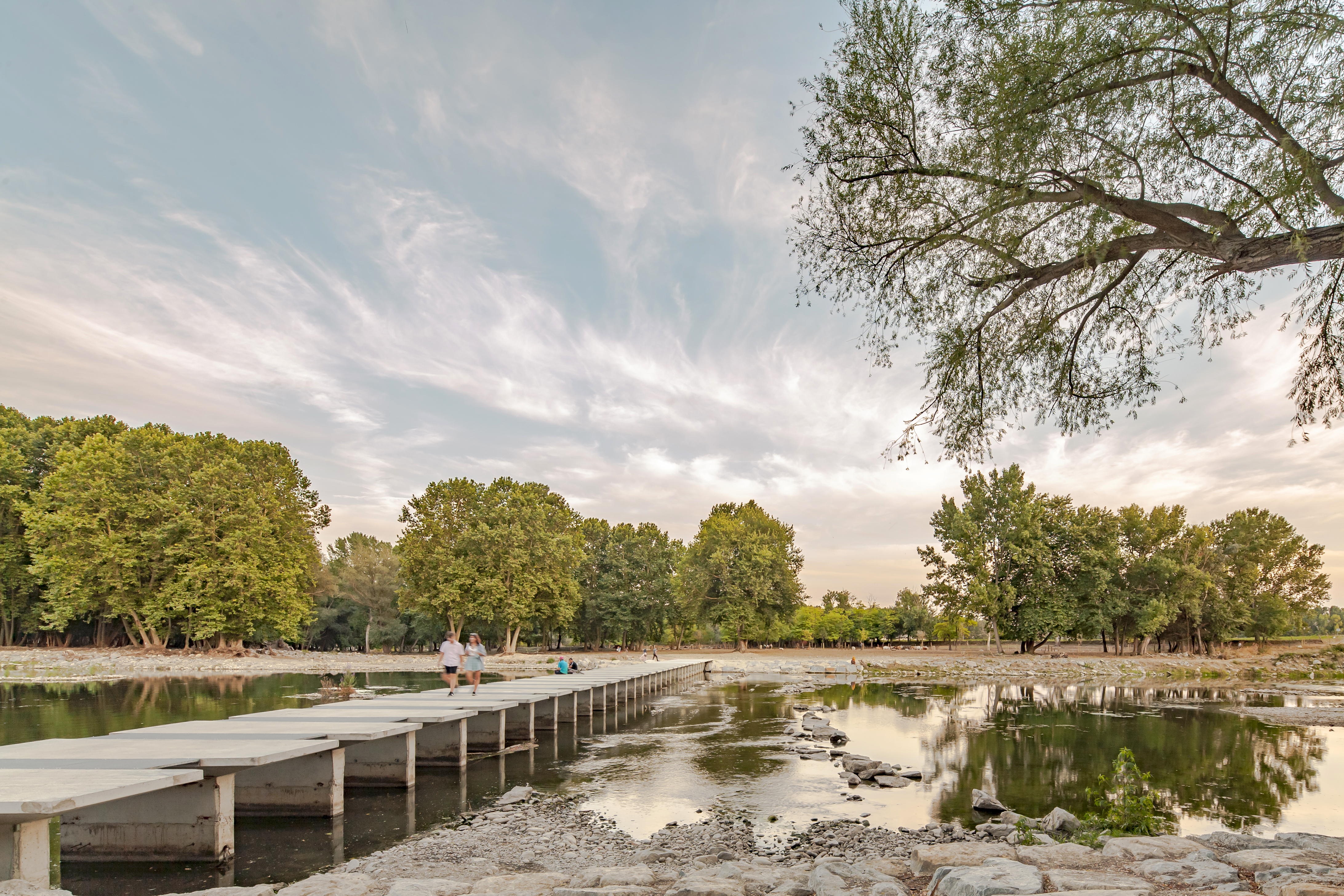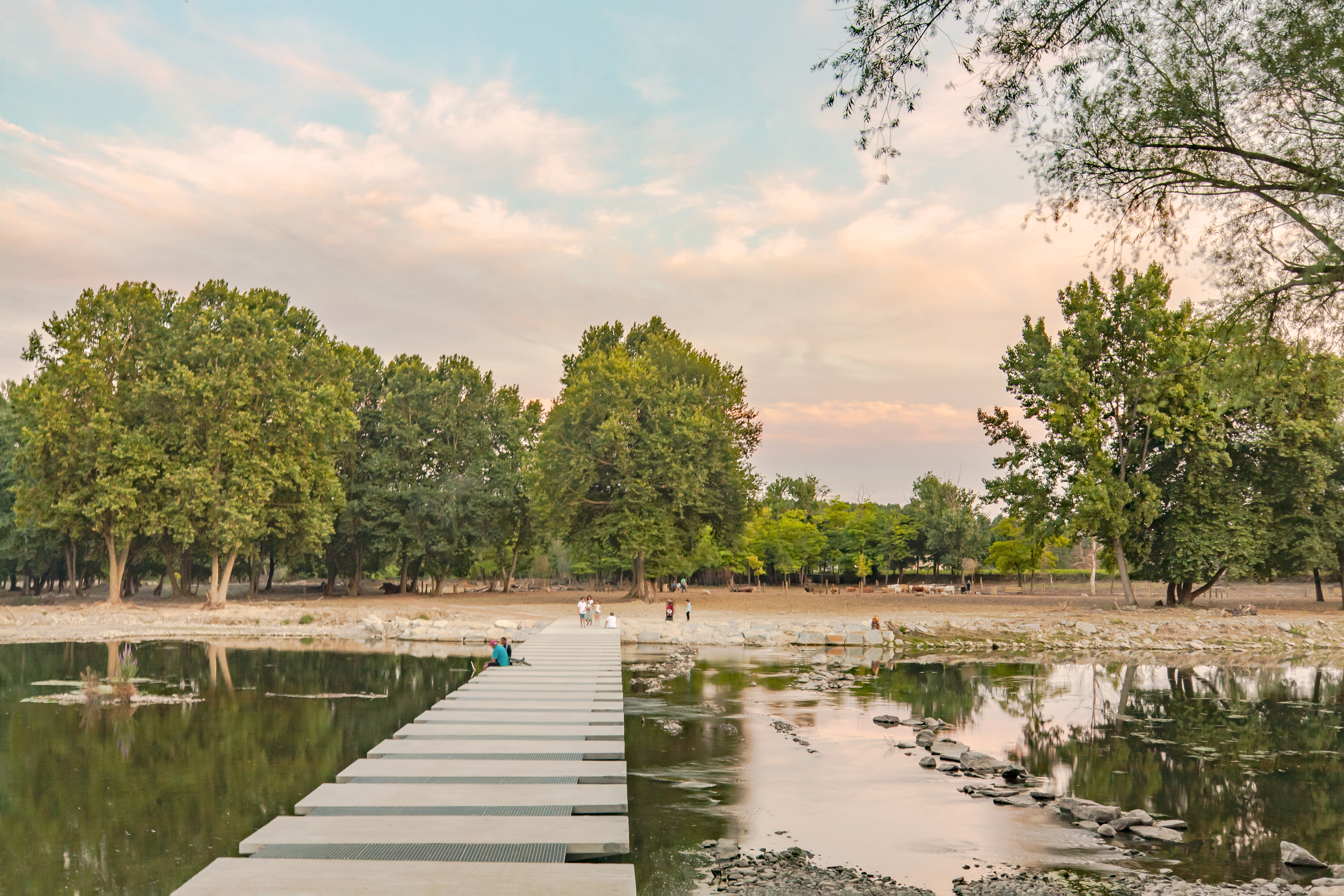The main aim of this foodable bridge is to become a catalyst for leisure, cultural, sportive and pedagogical activities around the river Ter in Manlleu. It can be explained from 3 basic approaches: First, from the territorial perspective to enhance the riverbeds as spaces of landscape interest; second, from the urban strategy, to consolidate the green playful-cultural axis tangent to the river; and finally, from the technical solution adopted; a very punctual action of low environmental impact.
The main aim of the project is to become a catalyst for leisure, cultural, sportive and pedagogical activities around the river Ter in Manlleu. It can be explained from 3 basic approaches: First, from the territorial perspective to enhance the riverbeds as spaces of landscape interest; second, from the urban strategy, to consolidate the green playful-cultural axis tangent to the river; and finally, from the technical solution adopted; a very punctual action of low environmental impact.
The project commitment to restoring the activity of the riverbeds which have always been magnificent ecotones, spaces that depend on the river's own ecosystem and that of its immediate surroundings. The proposal is based on the idea that, if we bring activity back to these places and blur the boundary between river and city, we will improve them, thus strengthening their maintenance and sense of belonging. The main aim of the project is, in fact, to allow the left riverbed to jump to the right, bringing this entire recreational-cultural axis into a large, previously residual area. In this way, Manlleu gains 30,000 m2 of open space.
Among all the possibilities, a "passallis", a floodable element, is chosen. Those are low-impact infrastructures; devices that are naturally incorporated into the river's own dynamics. The project proposes a series of concrete platforms that reminds us of the old river crossings. Over the years the flood bridge will progressively evolve: the colour of the concrete will change depending on the water levels, the walls will show the scars of stones and logs caused by the episodes of several floods, the metal framework will darken... In this way, the "passallis" will be transformed, like the banks of the river, into an ecotone: a transition zone between two ecosystems, the urban and the fluvial.
Please highlight how the project can be exemplary in this context
Among all the possibilities, a "passallis", a low-impact infrastructure, is chosen. The technical solution adopted is a very punctual action of low environmental impact. A "passallis", by definition, is a floodable element. Therefore, they are devices that are naturally incorporated into the river's own dynamics.
Used to bridges that do not respect the environment, that want to impose their presence, our proposal opts for the opposite: The river and its surroundings are the focus of attention. The lost prominence of the riverbank is restored with a structure that does not compete with it but accompanies it in its floods, in its natural dynamics.
Another important environmental consideration was to try to make use of the existing resources and, for instance, to re-use the earth for the construction work. Once the necessary earthworks had been carried out and the work on the entire section had been completed, the obvious need to reconstruct the riverbed was taken into account. It was decided that a balance maintained and, therefore, the earth that was excavated remained on the site and was later used for laying and compacting in other areas.
Please highlight how the project can be exemplary in this context
The project proposes a series of concrete platforms that reminds us of the old river crossings where you could pass from one riverbed to the other by jumping from one stone to the next. The shape responds to the needs of working in a river environment and, therefore, there is no formalism, but rather an effective response to the hydraulic and functional demands of the crossing. Beyond this inherent functionality, we have tried to "evoke" a past that is not so distant and that we want to transmit to new generations.
In terms of experience, it is a very important aspect for us that the people using the bridge feel the connection with the water and the floods. When crossing from one riverbed to the other, the pedestrian is outside the comfort zone of the urban ecosystem and , unprotected, becomes aware of the power of the river. The noise of the water lapping against the walls, the humidity, the change in temperature... everything immerses the pedestrian in the river ecosystem. The design of the project has taken into account the hydrological and climatological characteristics of the site as well as the fluvial dynamics of the point of implementation.
Of course, another key objective is to make the user to feel safe and secure. The river bed will be restored, clearing it of existing sediment and paving it to ensure the that the ground and the flow of water are stabilised prior to the arrival at the crossing, also making it difficult for gravel to accumulate in this area. This pavement will continue one metre further downstream in order to prevent the ground erosion caused by the water, thereby stabilising possible turbulences that could end up causing the foundations of the structure to collapse.
Please highlight how the project can be exemplary in this context
The project aims to incorporate users into the dynamics of the river with a clear commitment to citizen involvement. The proposal is based on the idea that, if we bring activity back to riverbeds and blur the boundary between river and city, we will improve them, thus strengthening their maintenance and sense of belonging. A new ludic-cultural axis tangent to the river on the left bank is emerging and must be promoted. Our foodable bridge allow the left riverbed to jump to the right, bringing this entire recreational-cultural axis into a large, previously residual area. In this way, Manlleu gains 30,000 m2 of open space full of opportunities, from the purely contemplative to sporting.
Educational activities can also be promoted, almost like an extension of the Museum of the Ter, an open-air museum where you can not only understand and explain the importance of the river and the ecosystems that surround it, but also the heritage value of the industrial fabric: locks, canals...
In terms of accessibility, the adopted technical solution (non-sliding platforms that not touch each with metallic grids at the same level in between them) allows, of course, for people with reduced mobility and wheelchair users to cross the river.
Please highlight how this approach can be exemplary
We succeed in meeting the values guides together. Starting with sustainability and biodiversity as, it is undoubtedly a project that has taken into account all ecological values. A low-impact structure has been chosen that merges with the surrounding landscape, without trying to impose itself but, on the opposite, blending in with the surrounding nature. With regard to aesthetics and quality of experience, we have to admit that the functionality itself has led us to find the right shape, but without forgetting that it has also helped to evoke the collective memory with this " stone by stone leap". In the dimension concerning to Inclusion, accessibility and affordability, the solution provided, as explained above, undoubtedly allows the bridge to be used by all kinds of people and the solution is affordable for the municipality.
We are eligible for the category “Reconnecting with nature” as a sustainable and inclusive project that bring Manlleu community closer to nature and contribute to regenerate the natural ecosystems of the river Ter and prevent loss of biodiversity.
As an “open air Museum” we invite the citizens to reconsider their relationship with nature. We provide a local solution to a global challenge.
Also, we could have entered also next category “Regaining a sense of belonging” because our “pasallís” is sustainable and inclusive project that contribute to bringing a sense of belonging, a “spirit” or “meaning” to the people around Manlleu. Our transformation of the river bed bring quality of experience benefits for Manlleu taking into account local cultural traditions and heritage, as well as local needs.
Please also explain the benefits that derived from their involvement.
This work was commissioned by Manlleu Town Council, which is a public and participatory institution. The local authorities have helped to raise questions that, as architects and landscape architects, we have had to answer, always bearing in mind the benefits for the community.
Our commitment to public projects always makes us set even higher expectations for ourselves, as the users are all the residents and visitors to the area. Designing "for everyone" is both a challenge and a privilege.
The global challenge is the recovery of riverbeds so that they can be reclaimed as public green space for the citizens.
We also highlight the focus on global and future forward thinking: Over the years the flood bridge will progressively evolve: the colour of the concrete will change depending on the water levels, the walls will show the scars of stones and logs caused by the episodes of several floods, the metal framework will darken due to the sun's radiation... In this way, the "passallis" will be transformed, like the banks of the river, into an ecotone: a transition zone between two ecosystems, the urban and the fluvial.
Our "Pasallís" is, as a bridge is supposed to be: safe, durable, reliable and stable. But unlike most bridges, it is at the same time "modest " in relation to the magnitude of the river and its surroundings.
It is considered that there are five main types of bridges: beam, cantilever, arch, suspension and cable-stayed bridges. Most of them have handrails and almost all of them are designed as elements that stand out from the rivers, that is, that stand out from the place. Our floodable bridge, however, accompanies the hydraulic dynamics of the river. It keeps up with the floods, integrates visually with it and, in a certain way, ends up being a companion of its presence.
We believe that all this is innovative. Not only for the use of materials or the technical solution adopted, but for this character of intending to integrate itself into the environment and at the same time to function as a catalyser.
Please provide clear documentation, communication of methodology and principles in this context.
With this “pasallís” we have learned to solve a problem from a global perspective and with a practical constructive solution that is simple to apply.
It is a simple project to implement, in fact, only requiring hydraulic concrete slab on micropiles, buried in the river bed. This foundation will be the base for a series of specially-shaped concrete pillars upstream, overhanging and with an inclination to support the platform, in order to allow the water to flow naturally and fluidly, and a concrete platform oriented upstream to each pillar, without turbulence, eroding the structure as little as possible. Particularly in Mediterranean climates and in rivers with moderate flows, it is an easily transferable approach to help regenerate areas close to riverbanks. In this way, abandoned areas can be brought back to life on a low budget.
We firmly believe that the knowledge, including constructive experiences, should be replicated in other places. We are aware of many riverbanks, especially in former industrial areas, which could benefit from the the experience gained in the construction of this project.






@Taller SAU SLP, 2021
Content licensed to the European Union.